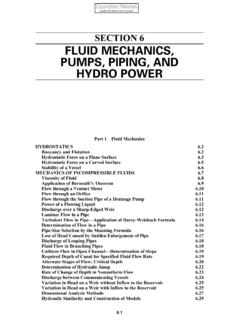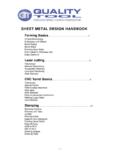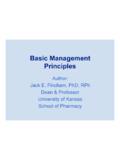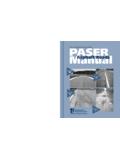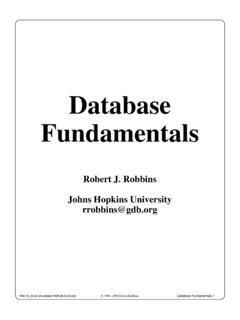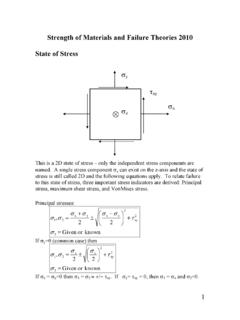Transcription of Principles, Materials and Methods - Hampshire
1 RE-POINTING - principles , Materials AND Methods 1 principles , Materials and Methods2 RE-POINTING - principles , Materials AND METHODSThe character of walls of brick, fl int and stone is derived from weathering characteristics, textures, and colours. The overall effect refl ects the age of the masonry and the care and attention to detail made in the construction. One of the most important, though often overlooked elements in masonry walling, is the pointing which lies between the faces of the bricks and stones. Re-pointing is the most common masonry maintenance practice; it is also the practice most frequently carried out badly. It is often modifi ed from the original in adverse ways which spoil the character and appearance of old masonry walls, leading to costly long term problems. The key ingredient and binding agent used in producing good quality pointing mortars for old masonry is building lime. A successful re-pointing project requires the use of a skilled contractor able to survey, specify, cost, and carry out the work in a way which respects the character and appearance of the masonry and its setting.
2 This work is especially important as it may adversely affect and devalue a listed building, Conservation Area or Area of Outstanding Natural Beauty. In addition to following traditions, there are sound environmental reasons for using lime Materials . The use of lime mortars conforms to sustainable construction practices. Unlike cement mortars, lime mortars are soft enough to be removed allowing bricks and stones to be re-used. Lime can be re-worked for longer and there is less wastage in construction. Lime production also uses 30 50% less energy than cement production. Pre-mixed dry, hydraulic lime mortars are now more widely available and are also produced in bulk quantities for more cost-effective new building projects in historic Pointing .. is crucial to the appearance, stability and durability of Britain s old buildings. The attractive appearance of this country s historic walls owes as much to the character of the jointing as to the bricks or stones themselves.
3 Making the Point , English Heritage, the disastrous visual impact of replacement bricks and full, wide joints against the fi ne jointed early 18th Century brickwork against which it has been the soft grey malmstone from the north-east of the county with sandy, yellow lime joints and dark garstone nails , often referred to as chalk ashlar range work mixed with squared, knapped black fl ints and tiles in a cement:lime:sand composition mortar which is beginning to create problems for the permeable : Shows tabular fl int in a black ash mortar gauged with History of Hampshire walling materials5 General principles for specifying lime mortars6 Surveying and recording 6 Mortar analysis7 Re-pointing Specifi cation8 Scheduling re-pointing work9 Re-pointing Methods10 Glossary of Pointing Terms10 Appendix: Mortar Mixes11 Materials Supply & Training 11 Further ReadingRe pwalling materor specifying lime mortarscordisHampshire is not rich in natural building stone but is most famously known as chalk country.
4 Much of the geology is based on a major chalk formation which continues into the county eastward from Salisbury Plain and rises north from Winchester. Chalk block has been used since Roman times for structural work and as a facing of core walls, but much more commonly chalk was used as rubble and in the corework of medieval and later buildings (see photograph a). Chalk has also been used for moulded and sculpted work, especially internally. Many of the old chalk quarries found around the county are likely to have been the source of much of the building lime burnt for mortar in lime kilns located on large estates, farmsteads and small landholdings. In the east of the county a belt of malmstone or greensand surfaces around Selborne where it can be seen as a creamy-coloured, random or coursed rubble facing stone in many building types (see photograph b). The freshwater limestone quarries at Quarr Abbey and nearby Binstead on the Isle of Wight have provided valuable building stone for major buildings in medieval times.
5 Many of these stones have been recycled for use in buildings and boundary walls since the dissolution of the monasteries. Some of the defensive forts along the Solent were constructed of these reclaimed stones. Walling stone was often re-used in chequered patterns by alternating blocks of freestone with fl is the most common building stone used in the county occurring as bands and nodules in the chalk and found in vast quantities on the sea beaches (see photograph c). Flint in the county, is rarely used alone History of Hampshire s Walling Materials RE-POINTING - principles , Materials AND Methods 3Re ppgRe-pointing Pointing describes the visible outer face of mortar joints where they appear on the surface of the wall. Re-pointing is the replacement of this outer face of mortar after it has been lost to weathering or damage. In much historic masonry, especially pre-17th century work, pointing is no more than the face of bedding mortar, which might or might not have a distinctive profi le applied to it.
6 In later work, the bedding mortar was raked back after the masonry had been raised and a plug of different mortar 10 or 15 mm thick was ironed onto the joint. The pointing mortar will usually be different from the mortar used in the structural core of the walls and may be different from the bedding mortar. The colour, texture and profi le of all face mortar has a profound visual effect on the wall. The composition of face mortar also plays a key role in reducing rain and wind penetration, and in allowing the wall to drain when wet, extending the life of the masonry. walling and is commonly used with brick, timber and chalk block in boundary walls and buildings. Squared, knapped fl ints are often used in higher quality work. Flint and timber-framing characterise the vernacular appearance of historic buildings in the central chalk uplands. The handmade brick industry is now fairly small in the county though excellent earths were dug in the past to produce high quality red bricks (for use in walling d).
7 Blue-grey bricks were also produced and used in decorative mortars for these walling Materials are based on lime, the source of which is limestone. Lime was produced as closely as possible to the building projects they were to supply. In Hampshire , the chalk downs provided abundant sources of stone suitable for burning for lime, for agricultural and building use. The relatively pure chalk produced lime which would only harden very slowly after mixing with water and exposure to air. These limes were described traditionally as air limes . One type of chalk often used was a grey chalk-rock which yielded a weak hydraulic lime. Mortars were commonly more lime rich than today. A reference to one old mortar mix specifi es: One-eighth wood ashes, one-eighth coal ashes, one-eighth dry sand, and one-eighth the white chalky clay malm, or marl found uniformly under the peat moors in the vallies .. and 4/8ths lime, procured from the grey, chalk-rock in the neighbourhood of Petersfi eld; the whole put together and tempered a few hours only before it is used.
8 [This is a one to one mix with the ashes contributing a weak hydraulic set]Sometimes the chalk contains a small percentage of clay Materials , principally silica and alumina, and a little iron. These stones, if fi red at slightly higher temperatures than the purer chalk, would produce limes which would develop a hydraulic set , when mixed with water. As the set of these limes occurred in water these limes were traditionally described as water limes .By the 18th century lime kilns existed on nearly every estate and farm, and more in coastal areas. Builders of that time would have been very familiar with the working properties and characteristics of their local limes though they were of variable quality and often not durable enough for the more demanding construction requirements of the day. From the mid-18th century scientists and the newly emerging profession of engineers began to forge links with entrepreneurs and industrialists in the search for cheaper, improved Materials , urgently needed to construct fi re resistant buildings to meet many new 4 RE-POINTING - principles , Materials AND of terraced housing, roads, bridges, tunnels, canals and harbour works.
9 The re-discovery of Britain s indigenous, hydraulic lime sources by John Smeaton in the late 18th century marked a turning point in construction history. Smeaton s work led to the patenting of later natural and artifi cial new Materials resulted in revolutionary changes to the scale and speed of civil engineering developments. The patenting of Portland cements marked the beginning of the decline of lime and local lime kilns were abandoned as the cement industry grew. The survival of traditional building Materials and the skills needed to revive their use seemed diffi cult to expect after the devastation of the World War II. In the small but signifi cant sector of architectural conservation the use of lime for ancient monuments and historic buildings was kept alive due to the work of the Inspectorate of Ancient Monuments and Historic Buildings. The landmark 1912-13 report by Frank Baines on the Use of Limes and Sands for Pointing described the whole question [of pointing].
10 As largely a matter of tradition, experience and rule-of-thumb work; no comprehensive record of the best manner of working has been published . Standard Methods for work on ancient monuments were recommended with all pointing to be done with hydraulic Blue Lias or Aberthaw limes. These standard Methods for pointing which Baines initiated and standardised, encouraged the survival of lime mortars for pointing and the skills needed to revive their use after the devastation of World War II. Large quantities of reliable sources of hydraulic limes continued to be produced in England until the 1960s when the last of the big hydraulic lime companies closed in East Anglia. Today hydraulic limes are available for all forms of repair work for historic buildings, from suppliers importing from the continent and from one source in the The more common, pure, white-coloured air limes produced by the large limestone quarry industries, are available in putty form for more specialised conservation importance of reverting to limes, which are now readily available, cannot be overstated in the light of the damage cements are known to cause to historic masonry.












